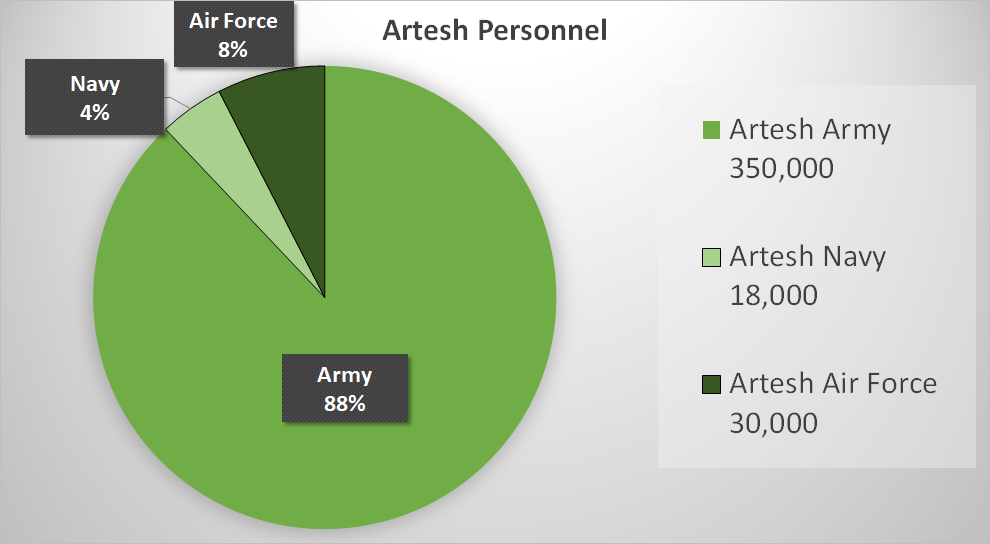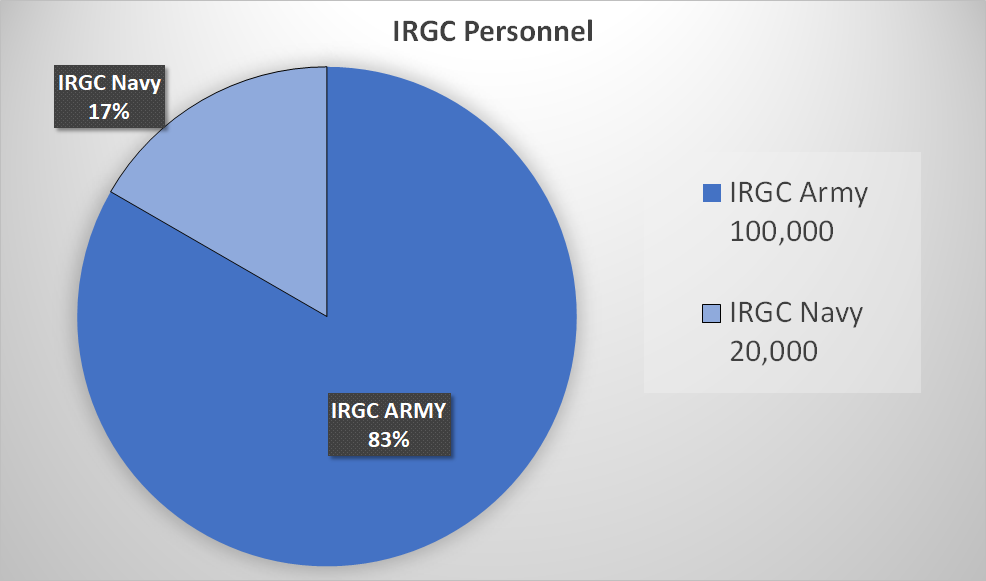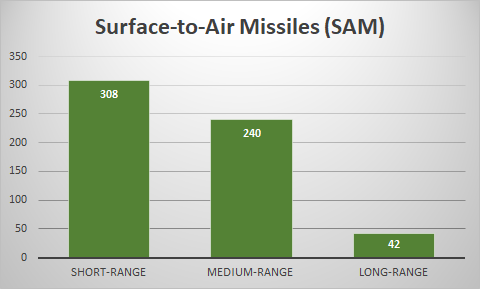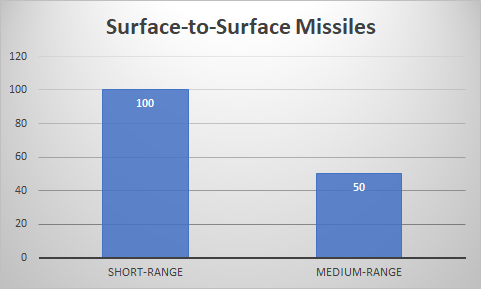Iran has two separate militaries. Its conventional forces, known as the Artesh, include an army, navy and air force. It is the largest wing, with a total of about 400,000 personnel. Its mission is to protect the independence and territorial integrity of Iran; it has historically focused on first-line defense against invading forces. Yet it has the smaller budget—about a third of the total defense budget in 2018—and older weaponry and warplanes.
The Islamic Revolutionary Guard Corps (IRGC) has its own army, navy and air force, with a total of some 125,000 personnel. According to the constitution, its mission is to protect the Revolution “and its achievements.” It has specialized in asymmetric warfare that has enabled Iran to exert influence through proxies and regional allies. It is allocated about two-thirds of the defense budget.
Under the constitution, however, the separate (and sometimes rival) wings of the military share a common mission. They are tasked to strive for jihad and expand “the sovereignty of the law of God.” The constitution cites the Koranic verse, “Against them make ready your strength to the utmost of your power, including steeds of war, to strike terror into the enemies, of Allah and your enemies.”

Source: “The Military Balance 2019” – The International Institute for Strategic Studies
*Iran has built a large paramilitary. The Basij is an auxiliary force under the Islamic Revolutionary Guard Corps (IRGC). It is tasked largely with internal security. It has 90,000 active forces, according to the Center for Strategic and International Studies. But the Basij can mobilize up to 1 million. Iran also has smaller paramilitary units for border security and law enforcement.
Anthony H. Cordesman outlined the Artesh’s capabilities in our chapter, linked here:
- Iran’s conventional military is severely limited, relying heavily on obsolescent and low quality weaponry. The Iran-Iraq War provided Iranian soldiers with extensive land combat experience, but Iran’s air combat capabilities are unimpressive. It has used missiles largely as terror weapons, but has not developed the accuracy, reliability, and lethality to use missiles against critical targets.
- But Iran’s forces are strong enough to create major problems for any invasion, and Iran can threaten its neighbors by fighting asymmetric wars. Its conventional military -- and Islamic Revolutionary Guard Corps (IRGC) -- have significant irregular warfare capabilities.
- Iran’s forces pose at least a near-term threat to shipping and tanker traffic through the Strait of Hormuz, the Gulf of Oman, and the Indian Ocean. It cannot win a war to “close the Straits,” but can create major problems for petroleum exports for at least a few weeks.
- Iran’s capabilities are enhanced by its steadily growing ballistic missile and long-range artillery rocket forces. Iran is also a major supplier of weapons and military advice to Iraq, giving the Islamic Republic influence over Hezbollah, Hamas, and Iraq’s armed Shiite groups. These forces act as a growing, if limited, deterrent to attacks on Iran, and compensate for the limits of its conventional forces.
- Iran’s ability to supplement its conventional forces with weapons of mass destruction is uncertain. It has acquired the capabilities necessary to obtain nuclear weapons but claims to have no intention to create such weapons. Iran has reached a tentative nuclear agreement with the world’s six major powers.
- Despite its threats to Israel, Iran is aware that Israel has advanced nuclear-armed missile forces and growing missile defenses. It is also aware that its Gulf neighbors have steadily improving missile defenses. Iran, however, has no meaningful missile defenses.

Source: “The Military Balance 2019” – The International Institute for Strategic Studies
Alireza Nader outlined the IRGC’s role in our chapter, linked here:
- The IRGC is Iran’s most powerful security and military organization. It played a crucial role in crushing early opposition to Khomeini’s vision and then repelling Saddam Hussein’s invasion of Iran in 1980. Since then, the IRGC has functioned as both the primary internal and external security force. It is in charge of executing Iran’s strategy of asymmetric warfare in the event of a U.S. or Israeli attack. It would most likely command a nuclear arsenal if the regime chooses to develop a nuclear weapons capability.
- The Guards have also developed an asymmetric naval strategy for use against the U.S. Navy. They have hundreds of fast attack boats, anti-ship cruise missiles, and naval mines. Together, they can impede U.S. operations in the Gulf, disrupt shipping, and impose a painful cost on U.S. forces in the event of an armed conflict. The Guards also operate hundreds of ballistic missiles that can target U.S. forces stationed in Gulf Cooperation Council countries, in addition to Israel and beyond.
- The IRGC’s secretive Qods Force has trained and equipped proxy groups, such as Hezbollah, Hamas, Iraqi Shiite insurgents. Surrogates have been used to target U.S. and other Western forces in Lebanon, Iraq and Afghanistan; they could be used against U.S. targets outside Iran in the event of a future conflict.
- The Guards are also Iran’s most powerful internal security force, at times cooperating and competing with the ministry of intelligence and other security organizations. The Guards’ intelligence organization appears to have eclipsed the ministry of intelligence in scope and authority, especially after the disputed 2009 presidential election.

*The IRGC also has a small air force that controls Iran's strategic-missile force.
Source: “The Military Balance 2019” – The International Institute for Strategic Studies
Iran’s Missile Program
Iran has the largest and most diverse ballistic missile arsenal in the Middle East, as outlined in Michael Elleman’s chapter linked here. (Israel has more capable ballistic missiles, but fewer in number and type.)
- Since the war with Iraq in the 1980s, Tehran has steadily expanded its missile arsenal. It is still dependent on foreign suppliers for key ingredients, components and equipment, but it should eventually be able to develop a long-range missile, including Intercontinental Ballistic Missile or ICBM. It has invested heavily in its own industries and infrastructure to lessen dependence on unreliable foreign sources. It is now able to produce its own missiles.
- Iran has demonstrated that it can also significantly expand the range of acquired missiles, as it has done with Nodong missiles from North Korea, which it then renamed. Iran’s missiles can already hit any part of the Middle East, including Israel. Over time, Tehran has established the capacity to create missiles to address a full range of strategic objectives.
- The Islamic Republic is the only country to develop a 2,000-km missile without first having a nuclear weapons capability.
- The military utility of Iran’s current ballistic missiles is limited because of poor accuracy, so missiles are not likely to be decisive if armed with conventional, chemical or biological warheads. But Tehran could use its missiles as a political or psychological weapon to terrorize an adversary’s cities and pressure its government.
- Iran’s space program, which includes the successful launch of a small, crude satellite into low earth orbit using the Safir carrier rocket, proves the country’s growing ambitions and technical prowess.

Source: “The Military Balance 2019” – The International Institute for Strategic Studies

Source: “The Military Balance 2019” – The International Institute for Strategic Studies
The following is a list of Iran’s missiles by their name and range:
Koksan M1978: 40-60 km (20-40 miles)
Ra’ad: 150 km (100 miles)
Tondar 69: 150 km (100 miles)
Fateh-110: 200-300 km (120-190 miles)
Soumar: 2,000-3,000 km (1,240-1,860 miles)
Shahab-1: 285-330 km (180-210 miles)
Safir: 350 km (220 miles)
Shahab 2 (Scud C-Variant): 500 km (310 miles)
Zolfaghar: 700 km (430 miles)
Qiam-1: 700-800 km (430-500 miles)
Shahab-3: 1,300 km (810 miles)
Sejjil: 2,000 km (1,240 miles)
Soumar: 2,000-3,000 km (1,240-1,860 miles)
Source: Missile Defense Project – Center for Strategic and International Studies
All data sourced from “The Military Balance 2019” by The International Institute for Strategic Studies (with permission) unless otherwise noted. See the full publication for more detailed information. The graphs were produced by The Iran Primer.
